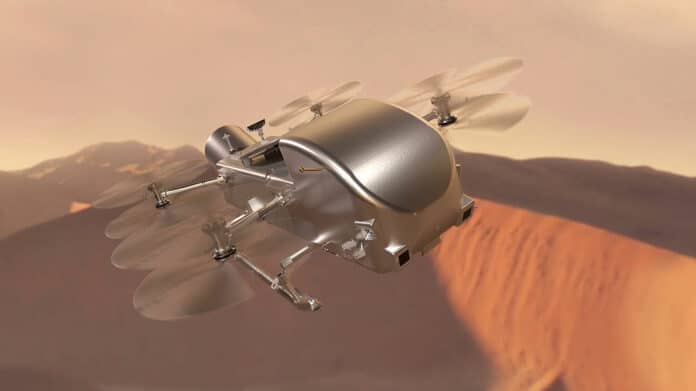NASA’s Dragonfly mission team has announced that they are progressing toward the next stage of development for their ambitious, nuclear-powered drone. The car-sized drone is designed to fly over and land on the organic-rich sands of Saturn’s largest moon, Titan.
The team will now work on the final mission design and fabrication of the vehicle, known as Phase C.
Dragonfly passed its Preliminary Design Review earlier this year. Also, they have completed a replan of the mission based on funding levels in the fiscal year 2024 president’s budget request, and a revised launch readiness date of July 2028 has been established – originally, it was set to head to Titan in 2027. NASA will officially assess the mission’s launch readiness date in mid-2024 at the Agency Program Management Council.
“The Dragonfly team has successfully overcome a number of technical and programmatic challenges in this daring endeavor to gather new science on Titan,” said Nicola Fox, associate administrator of NASA’s Science Mission Directorate in Washington. “I am proud of this team and their ability to keep all aspects of the mission moving.”
Dragonfly is the only NASA mission set to explore the complex chemistry on the moon of Saturn and even hunt for signs of water or hydrocarbon-based life that already exist there. Johns Hopkins Applied Physics Laboratory will build and operate the vehicle, which will be equipped with cameras, sensors, and samplers to investigate areas of Titan where organic materials may have previously mixed with frozen water on the planet’s icy surface.
The four dual-bladed rotorcraft are expected to travel further across Saturn’s surface than any other planetary rover ever has. Additionally, they will land on different regions of the planet and collect samples to determine the composition of surface materials under varying geological conditions.
“Dragonfly is such a daring endeavor, like nothing that has ever been done before,” said APL’s Elizabeth “Zibi” Turtle, Dragonfly’s principal investigator, in a statement. “I’m inspired by the way our team has repeatedly overcome challenges by working together and thinking outside the box. We’ve demonstrated that we’re ready for the next steps on the path to Titan, and we’ll keep moving forward with the same curiosity and creativity that have brought Dragonfly to this point.”
The Dragonfly team has made significant technical strides. Several Dragonfly components, including its guidance, navigation, and control systems, have already been tested over California deserts that resemble Titan’s dunes as well as in the one-of-a-kind wind tunnels at NASA’s Langley Research Center. A full-scale, instrumented lander model has also been tested in APL’s new, 3,000-cubic-foot Titan Chamber, which simulated the temperature and atmospheric pressure of Titan’s methane-rich environment.
